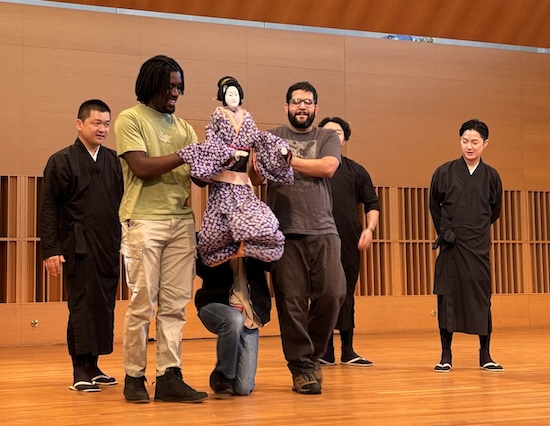
This article mentions depictions of suicide in a theater production.
The moon hangs heavy over the lonely woods of Sonezaki, where two lovers vow to escape a world that shuns their devotion. In another village, a desperate woman battles the howling wind and blowing snow as she climbs up her city’s watchtower. Drums of fate echo through the theater, carrying the audience into an enchanting world of puppetry.
These heart-wrenching moments took the stage on Tuesday, Oct. 1, at the Aloysius P. Kelley, S.J. Theatre in Fairfield, Conn., where the National Bunraku Theater from Osaka, Japan, made its Connecticut debut to a sold-out audience. As part of its U.S. tour, the Japanese puppet theater troupe performed excerpts from two timeless plays in a production co-presented by Wesleyan’s Center for the Arts (CFA) and Fairfield University’s Quick Center for the Arts.
The evening’s event opened with a pre-performance lecture by Professor of Theatre and Performance Claudia Orenstein from Hunter College, City University of New York (CUNY). A leading scholar on puppetry performance, Orenstein provided the audience with valuable insights into the history, technique, and cultural significance of this sophisticated form of art.
As Orenstein explained, bunraku, or ningyō jōruri, broadly refers to Japanese traditional puppet theater. Known for its three-person puppet manipulation technique, bunraku has been designated as an Intangible Cultural Heritage of Humanity by UNESCO.
In a bunraku performance, three puppeteers control a single puppet with a remarkable level of precision and artistry. The lead puppeteer, known as the omo-zukai, controls the puppet’s head and right arm. A second puppeteer, the hidari-zukai, manages the left arm, while a third, the ashi-zukai, handles the legs. These three puppeteers must work in perfect harmony, coordinating their movements to create realistic gestures and expressions that bring the puppet to life.
But a bunraku performance could not be complete without the chanter and shamisen artists. The chanter (tayū) provides a stylized narration (jōruri) by using different tones and adjusting the timbral quality of their voice that distinguishes between different characters. The chanting is accompanied by three-stringed shamisen instruments, which enhance the play’s emotion and mood while adding dramatic emphasis. The chanter and shamisen artists always sit in a kneeling position on the stage left, on a platform built as their exclusive performing space.
The Oct. 1 performance featured two climactic scenes from the bunraku repertoire, both rooted in actual historical events. The first scene came from “Date musume koi no higanoko” (“Oshichi, the Greengrocer’s Daughter”), co-written by Sensuke Suga and Wakichi Matsuda in 1773. The audience was introduced to Oshichi, who, consumed by her love for the temple pageboy, attempts to save his life by climbing up the city watchtower and ringing a false fire alarm, despite knowing that this action would lead to her death. The tension in this scene was palpable, with Yoshida Minotarō, the lead puppeteer, expertly manipulating Oshichi’s puppet to convey her emotional turmoil and the way it turned from deep pain to a determined resolve to save her lover.
The second half of the performance presented the culminating scene from “Sonezaki shinjū” (“The Love Suicides at Sonezaki”). Premiering in 1703, “Sonezaki shinjū” was one of the most renowned works of master dramatist Chikamatsu Monzaemon. In the gripping final scene that the group performed, two doomed lovers—the young merchant Tokubē and the prostitute Ohatsu—commit double suicide in hopes of being reunited in the afterlife. Once again, the lead puppeteers (Yoshida Tamasuke and Yoshida Minoshirō) demonstrated expert manipulation, instilling in their ningyō enough realism and emotive power to wrench the audience’s heart and reawaken this centuries-old tragic tale of love and sacrifice.
The production’s artistry was not limited to the puppeteers alone. The tayū—Toyotake Tōdayū, Toyotake Yoshihodayū, and Toyotake Sakijudayū—brought their masterful vocal interpretations to the characters, weaving together the heartbreaking narratives and emotions unfolding on stage. Their chants were accompanied by the shamisen musicians—Tsuruzawa Seishirō, Tsuruzawa Kantarō, and Tsuruzawa Seiin—whose melodies added tension and drama to the puppetry performance, creating an almost spiritual experience.
Additionally, the production was also notable for its innovative blend of bunraku with anime-style scenic projections by Kazuo Oga, known for his work on classic Studio Ghibli films such as “My Neighbor Totoro” (1988) and “Princess Mononoke” (1997). The traditional wooden sets which typically ground a bunraku performance were reimagined with a modern dream-like quality—a stark departure from the original aesthetic so as to tailor the production to the global stage.

In between the two scenes, the evening’s program also included a puppet manipulation demonstration led by Kiritake Monyoshi. Following an interpretation by Chair of the College of East Asian Studies Takeshi Watanabe, the audience marveled at the level of precision and skill required to make the puppets move so naturally. Each motion, whether a simple tilt of the head or a graceful bow, was the product of years of dedicated training. The puppeteers explained how every detail, from the puppet’s design to the coordination between the operators, was meticulously crafted to evoke a specific emotional response from the audience.
As the curtain fell on the final scene of “Sonezaki shinjū,” the audience erupted into applause, honoring the tremendous talent of the performers who had traveled afar to bring forth the whirlwind of emotions they just experienced.
“On October 1, a bunraku performance took place at Fairfield University in Connecticut,” the National Theatre Tokyo wrote in an X post on Oct. 4. “People of all ages packed into the venue to enjoy the charm of bunraku. During the curtain call, we received a warm standing ovation.”
At the same time, sitting among a predominantly white audience, I couldn’t help but wonder if this exquisite production reproduced familiar tropes of orientalism. In a context so far removed from its origins, it’s easy to view bunraku merely as a spectacle of exotic otherness. Still, the production stands as a testament to the enduring power of art to connect people across cultures and time.
Wesleyan’s CFA provided free two-way transportation for audience members who were traveling from campus. Some courses—such as “Space Design for Performance” (THEA 359), “Dressing the Imagination” (THEA 284), “Acting I” (THEA 245), “Voice & Movement for Actors” (THEA 355), and “In Search of the Good Life in Premodern Japan” (CEAS 295)—required their students to attend the performance, and many reacted positively to the experience.
“Although I grew up in Japan, I’d only known bunraku as a traditional performance too complex for my taste,” Miho Yamashita ’28 wrote in a message to The Argus. “So I was astounded when at Fairfield University, I realized how intricate, dynamic, and relatable Bunraku was. The emotions portrayed eloquently by the puppeteers were universal—for example, Sonezaki Sinju beautifully depicts two lovers’ despair as they commit suicide—and I understood the enduring value of bunraku as a form of art and entertainment.”
The National Theater troupe also delivered a lecture demonstration at Crowell Concert Hall on Monday, Sept. 30, offering the Wesleyan community a rare glimpse behind the scenes of traditional puppet theater. Students not only watched professional puppeteers work in perfect unison but were also allowed the opportunity to experience puppet manipulation up close, taking their shot to control different parts of the puppet’s body.
“At Wesleyan University near Fairfield…we welcomed about 100 participants,” the National Theatre Tokyo’s X account wrote on Thursday, Oct. 3. “They became familiar with bunraku through explanations of the three-person technique and hands-on puppetry demonstrations.”
One of the tayū, Sakijudayū, spoke fondly of his time at Wesleyan.
“All the students and professors I met at this university were very sincere and genuine,” Sakijudayū wrote in an X post on Wednesday, Oct. 2. “I want to come back again. ☺”
Sida Chu can be reached at schu@wesleyan.edu.



Leave a Reply